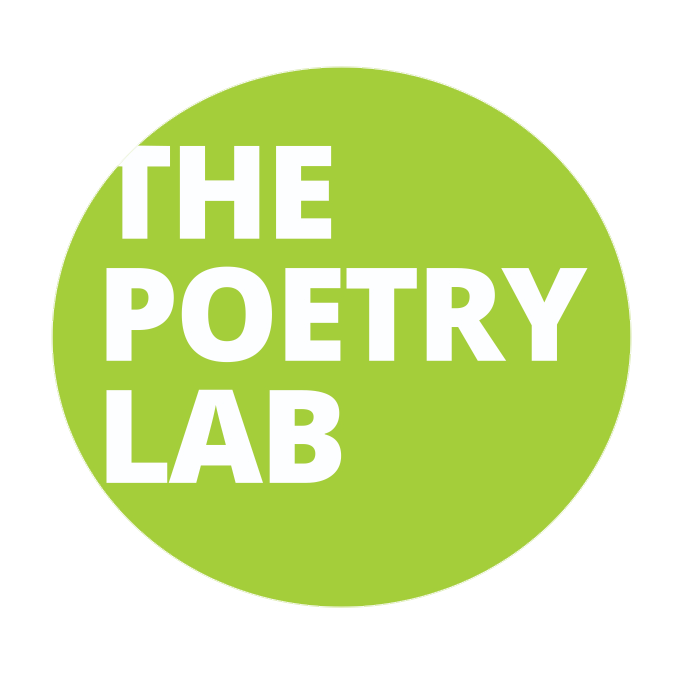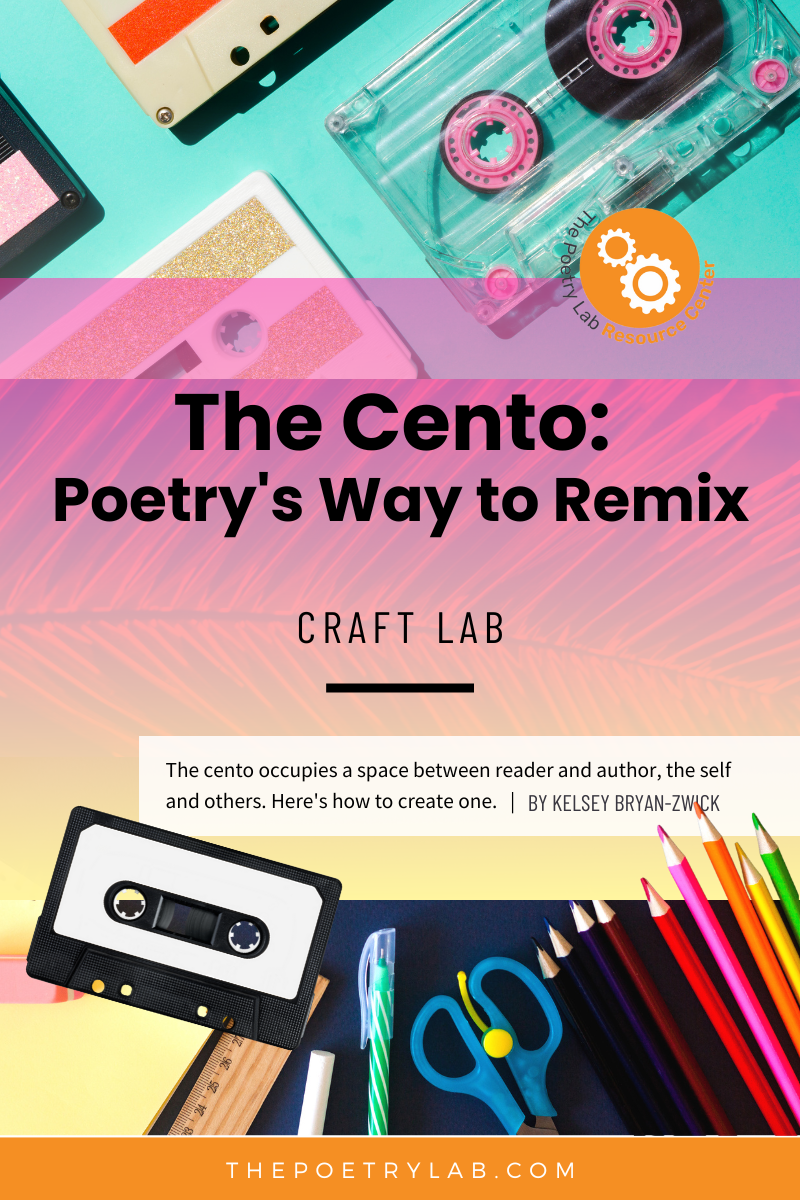
The Cento: Poetry’s Way to Remix
craft lab
KELSEY BRYAN-ZWICKGO BACK TO THE RESOURCE CENTER >
Discovering new forms of poetry
can sometimes feel like finding a needle in a haystack. Finding a form that perfectly fits a poem idea turns that pile of hay into gold. This at least was my experience with the cento as it is a form I discovered in reverse. I wrote a poem draft and then searched and searched the proverbial haystack until I could figure out what it was I was trying to write.
After the 2016 election, and the horror I feared would ensue, I was heart broken. I kept hearing the words of Emma Lazarus’s*, “The New Colossus,” whose lines proclaim, “Give me your tired, your poor,/ Your huddled masses yearning to breathe free[.]” These are the words that adorn the statue of liberty. I was hearing the words but in a different rhythm and tone. I was hearing Emma’s words inside the structure of Sylvia Plath’s, “Mad Girl’s Love Song,” and my mind was transposing lines from the first poem into Plath’s villanelle that reads, “I shut my eyes and all the world drops dead;/I lift my lids and all is born again.” To soothe my soul that post-election-day I created this newly imagined version hobbled together by the poetry of these two authors (and when I realized the title a third author, Billie Holiday, also delivered a central piece to what became this new poem).
Once the poem was drafted, I was stuck. I didn’t know what to do with it because I didn’t know how to credit it or what to call it. I scoured the internet with reverse definitions as best I could but was having trouble finding the right poetry term. This wasn’t exactly erasure or pastiche poetry. I then remembered my friend and poet LeAnne Hunt* blogs about poetry prompts. It was there that I finally found the description of the cento! That is:
A Cento is a poem made up from the words of other writers.
Doing the Wikipedia-internet-research-spiral I discovered that this is indeed an ancient form, one of the first known examples is by the Roman author, Hosidius Geta, who used lines from Virgil to compose his original work, Medea, written sometime in the 2nd-3rd century AD. In Greece it was also in practice to use lines from Homer to create new works. Recalling familiar lines was especially useful to oral traditions, because it entertained and engaged the gathered audience.
“The Latin term cento derives from Greek κέντρων (gen. ), meaning "'to plant slips' (of trees)," says Wikipedia. A later word in Greek, κεντρόνη, means "patchwork garment". I like both of these translations, as writers we are often called “weavers,” of stories, and so a cento is this “garment,” made up from snippets of cloth woven by other authors. And If these stories have a purpose it is to plant ideas that will one day thrive and forest and bloom for the reader. It is an exciting form when thinking about the progression of ideas, the pedagogy of thoughts that we as readers and writers must cultivate. The cento occupies a space between reader and author, between the self and others.
There are many ways to collaborate through the cento. It’s no surprise that the cento has become a form I’ve returned to over the years. It is a way to remix and sample from the greats, from the poets you want to be in conversation with. And it is a powerful lens into the use of voice. Centos allow us to do close reading of the original text, whether positive or negative. Playing with someone else’s words brings a whole new insight into just how they are functioning within a poem and the tricks the author is implementing.
This is a form that can be used to modernize voices
from the past or to completely flip them on their logic. Centos can be a form of critique to works by authors that are misleading or offensive to you—a way to confront voices that are racist, bigoted, or sexist. These voices can be rearranged and reconfigured to find whole new meanings or just to point out the error of perspective.

Centos also extend beyond the scope of poetry as you are not limited to re-configuring only poetry, as it happens, any word-based form can be transformed into a cento. This is one way you can be in conversation with any writer from any point in time. You can limit your cento to one voice or, as I did, combine different voices/writers into one piece. Though if you seek chaos, this can be achieved with the cento as well, by having voices in conflict instead of being in harmony with one another.
This form is similar to erasure poetry, where likewise a pre-existing text is being used to create a new poem. The cento also has some elements of the pastiche poem, which cuts out words and phrases from a source and then rearranges the lines to make a new poem. What I love about all of these forms is they invite writers into a space that differs from the blank page. There is no need to create every poem from scratch, instead, in using existing materials this form is akin to collage. In times of the notorious writer’s block these aspects of the cento make it an excellent option in getting the creative muscles working again.
Important notes before you write your first cento!
I will note that it is important to properly credit your cento poems, borrowing without credit would be considered plagiarism. That was one of the reasons that drove me to understand this form before I could share my poem or submit it for publication. It was in learning what a cento was and how to acknowledge where the lines had come from that has ultimately allowed me to play with a whole new realm of language. To credit a cento it is enough to simply state author names, but I have found that annotating, or giving detailed notes at the end of the poem is often very useful to readers and much appreciated by publishers, so feel free to really nerd-out and document where and how you found what.
Our favorite Cento Prompt at The Poetry Lab:
Look around for some favorite books, or titles that you love.
Arrange the books in a stack, so that from top to bottom you can read the titles on the spine of the books.
Presto, you now have a cento poem made from book titles!
Article Resources:
Fun fact, Emma Lazarus’s poem, “The New Colossus,” written in 1883 was auctioned to raise funds to build the foundation on which The Statue of Liberty rests, though this iconic American poem was not included as part of the monument until 1903, over fifteen years after Lazarus’s death.
You can find LeAnne Hunt’s blog on poetry prompts here: https://leannehunt.com/
My poem, “Lady Liberty Sings the Blues,” can be found on Writing in a Woman’s Voice: https://writinginawomansvoice.blogspot.com/2019/07/lady-liberty-sings-blues-new-cento-by.html
👉 Beyond poetry
Any word-based form can be transformed into a cento. Here’s an example by our director, Danielle Mitchell, published in the Four Way Review called “Google Cento”. In the poem, Danielle uses the Google search results page as the material repurposed into the poem.
This article was published on October 28, 2021. Written by:



